It's peak holiday season, and your ecommerce store is buzzing with new arrivals. But instead of capitalizing on the frenzy, you're stuck waiting weeks for a photographer to capture that perfect shot of your latest winter coat—only to shell out thousands in fees. Meanwhile, competitors flood feeds with vibrant, trend-aligned visuals that convert browsers into buyers at lightning speed. 75% of online shoppers base their purchase decisions solely on product images. That's a direct hit to your bottom line, with high-quality photos boosting conversions by up to 94%.
Enter product photography with AI—the trend that’s catapulting small-to-medium ecommerce brands into hyperdrive. With AI tools, you can transform a single basic snapshot into a suite of lifestyle, studio, and seasonal images in minutes, slashing costs and timelines while keeping your listings fresh and irresistible. In this guide, we'll unpack the pitfalls of traditional methods, map out AI-powered workflows, and dive into hands-on strategies using innovative platforms like Yarnit.
The Hidden Costs and Roadblocks of Traditional Product Photography
Traditional product photography has long been the gold standard for ecommerce, crisp studio shots on white backgrounds or aspirational lifestyle scenes that evoke desire. But in 2025, as inventory turns faster and trends shift weekly, its drawbacks are glaringly exposed.
First off, the financial bite: The global ecommerce product photography market is valued at $1 billion this year alone, but for individual brands, costs add up quickly. A single professional image can run $75 to $350, with basic studio setups starting at $25–$150 per shot and advanced retouching tacking on $10–$50 more. Lifestyle shoots? Expect to pay two to three times that premium, often $500–$3,000 per day for custom setups involving models, props, and locations.
Scale that across a catalog of 100+ SKUs, and you're looking at tens of thousands annually—plus hidden fees like rush charges or seasonal surges that inflate rates further. For small businesses, this is a scalability killer. Updating listings for holidays or viral trends means reshooting everything, delaying time-to-market by 4–6 weeks from production line to platform upload. Factor in shipping products to studios, insurance, and revisions (which blow 40% of projects over budget), and the ROI plummets.
Then there's the creative crunch: Ecommerce demands more than flat images. Shoppers crave context—how does that sunscreen glisten on a beach day? Without diverse, appealing visuals, cart abandonment spikes, as many. buyers deem images "extremely influential" in decisions. Yet hiring specialists for varied styles drains resources, leaving brands reactive rather than proactive. It's time to flip the script.
Why Product Photography with AI Is the Scaling Superpower Your Store Needs
The AI for product photography market is exploding, hitting $500 million in 2025 with a blistering 25% CAGR through 2033. Why? Because it democratizes pro-level visuals, turning novices into creators overnight.
Time management: AI streamlines image editing by automating tasks like removing backgrounds, adjusting lighting, and creating multiple image variants. This reduces a process that typically takes weeks down to just a few hours. It also improves image quality on the spot by fixing shadows and sharpening details, making workflows much faster and more efficient.
Cost Saving: By using AI tools, small businesses can drastically cut costs. Traditional image editing can cost over $75 per photo, but AI solutions bring this down to less than $1 per image. This makes professional-quality visuals accessible to businesses with smaller budgets, allowing them to invest resources elsewhere.
Adoption: 75% of photographers now use AI for editing, and 61% for on-the-fly improvements. For ecommerce, this means agile listings that align with trends, boosting engagement and sales in a visual-first world. For ecommerce, AI helps brands quickly update product images to reflect trends and customer preferences, leading to better engagement and higher sales. This shift shows how AI is becoming essential for staying competitive in a visual-driven market.
Traditional Workflow vs. AI-Powered Product Photography
To grasp the transformation, let's timeline a product's journey from factory to storefront.

The delta? AI slashes time-to-market by 25–40%, freeing teams for strategy over logistics. No more seasonal silos—refresh visuals on-demand, keeping your store dynamic.
Traditional Workflow vs. AI-Powered Product Photography
To grasp the transformation, let's timeline a product's journey from factory to storefront.
Traditional Workflow:
- Production to Prep (1–2 weeks): New batch arrives; select samples, ship to studio.
- Shoot Setup (1–3 days): Book photographer, rent space/gear, style with props/models.
- Capture and Initial Edits (3–7 days): Shoot 10–20 angles/styles; basic culling.
- Post-Production (1–2 weeks): Retouch for consistency, generate variants manually.
- Upload and Optimize (2–5 days): SEO-tag, A/B test, platform tweaks.
Total: 4–8 weeks, $500–5,000 per product line. Bottlenecks abound—delays from weather, artist availability, or revisions kill momentum, especially for seasonal drops.
AI Workflow with Product Photography Tools:
- Upload Basic Shot (Minutes): Snap a smartphone photo of the product on a plain background.
- Generate Variants (5–30 Minutes): Input prompts like "sunscreen on tropical beach at sunset"; AI creates 10+ lifestyle/studio images with perfect lighting and composition.
- Auto-Edit and Optimize (Instant): Tools apply brand filters, remove flaws, and suggest trend-based tweaks (e.g., festive overlays for holidays).
- Download and Integrate (Minutes): Export high-res files, auto-generate alt text/SEO, upload to Shopify or Amazon.
Total: Hours to 1–2 days, under $50 per batch.
The delta? AI slashes time-to-market by 25–40%, freeing teams for strategy over logistics. No more seasonal silos—refresh visuals on-demand, keeping your store dynamic.
How Can Yarnit Scale Your Product Photography?
Let's walk through generating pro images for Hyphen's sunscreen using Yarnit.
Step 1: Upload and Prompt
Upload your product's clean shot (e.g., the sunscreen bottle against a white backdrop). Add a brief description: "Place this sunscreen on a beach." This seeds the AI with context, ensuring outputs feel authentic and shoppable.
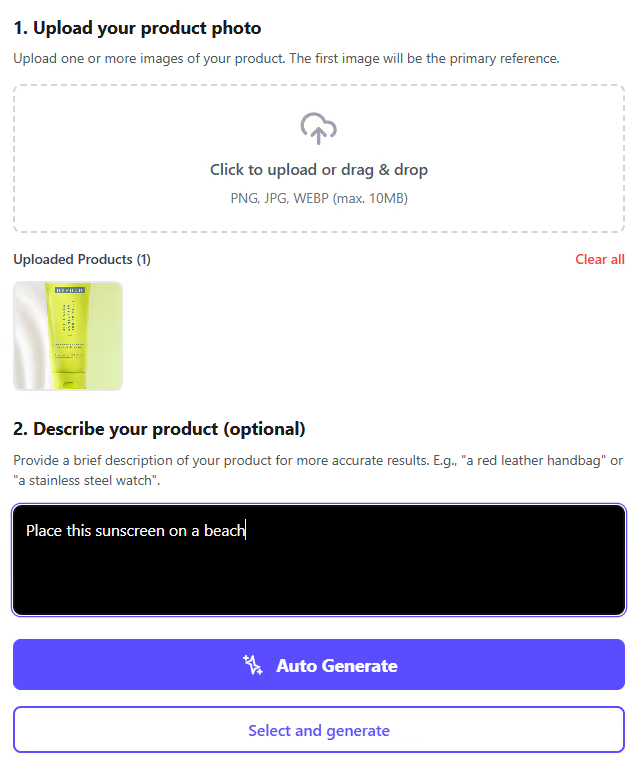
Step 2: Auto Generate Magic
Hit "Auto Generate," and watch AI conjure variations in seconds. Output includes a hyper-realistic scene: the bottle gleaming on the beach with sunglasses on the side. Hover for controls—full-screen preview, animate for video snippets, or download the image
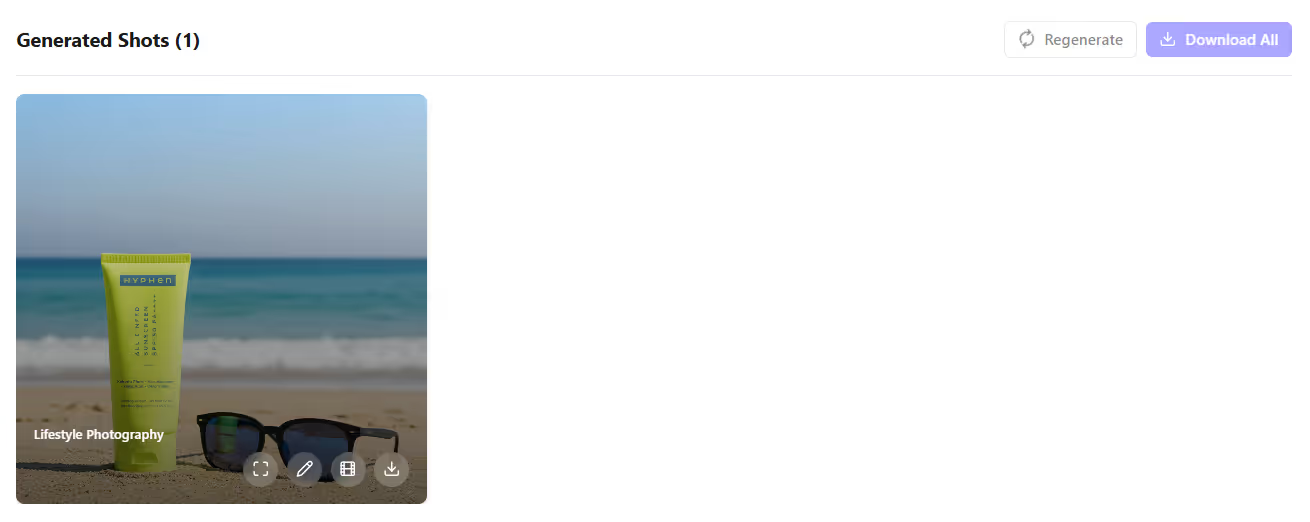
Step 3: Select and Style
Another way to go on about this is by clicking on "Select and Generate" for different product image styles. You can select photography styles to your liking, adjust angles, or infuse trends like eco-friendly props.
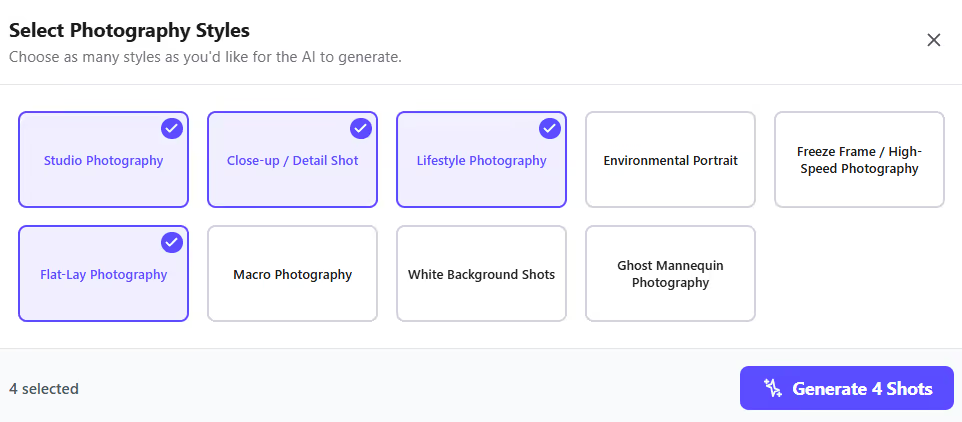
Output:
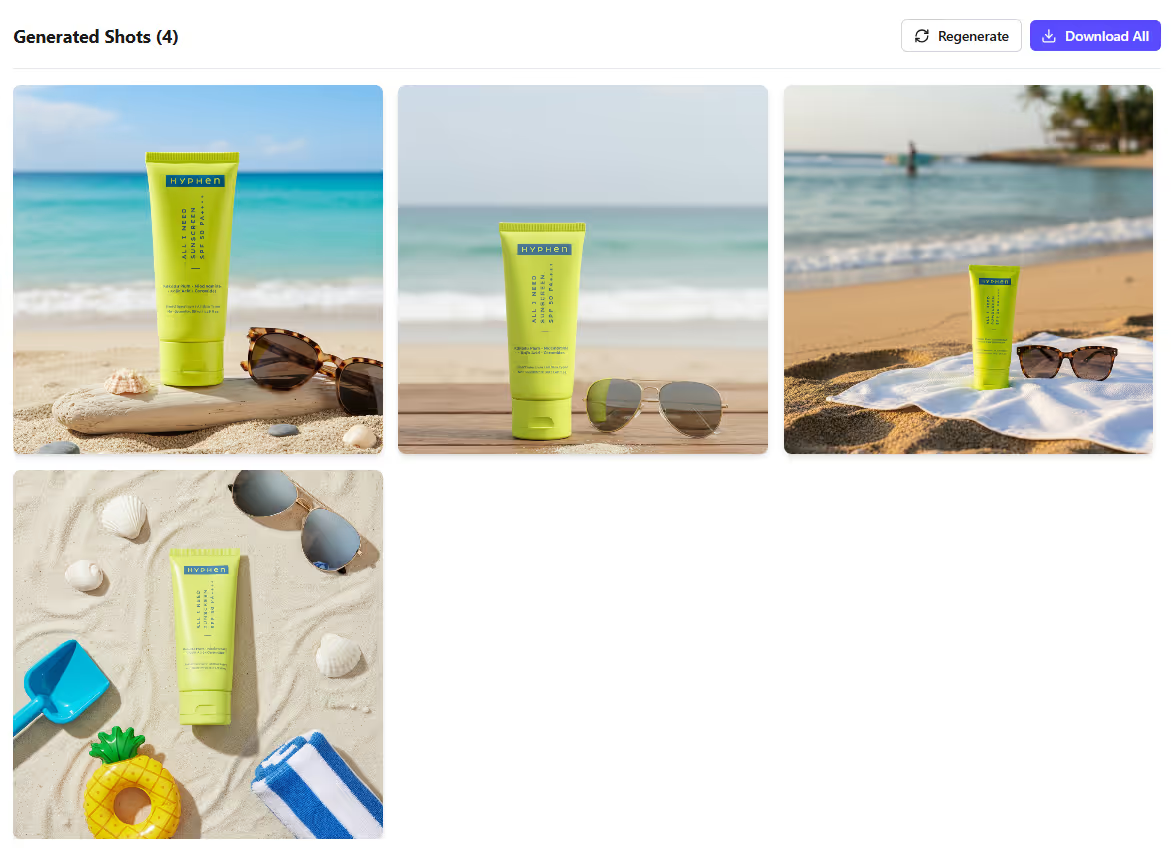
Step 4: Edit and Polish
Hover on any image and select "Edit." Let’s say you want to enhance the beach vibes by adding more props to the lifestyle image. You can edit instructions by saying something like - “Place a mocktail beside the sunscreen”
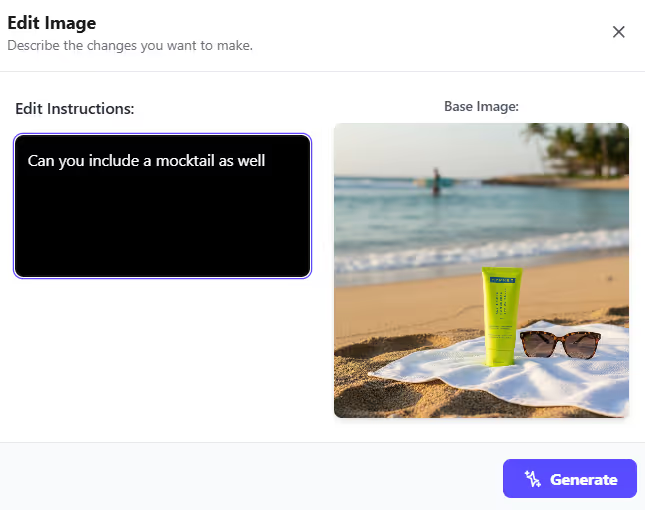
Step 5: You get the edited version of the lifestyle photography. You can choose to download it or edit it further!
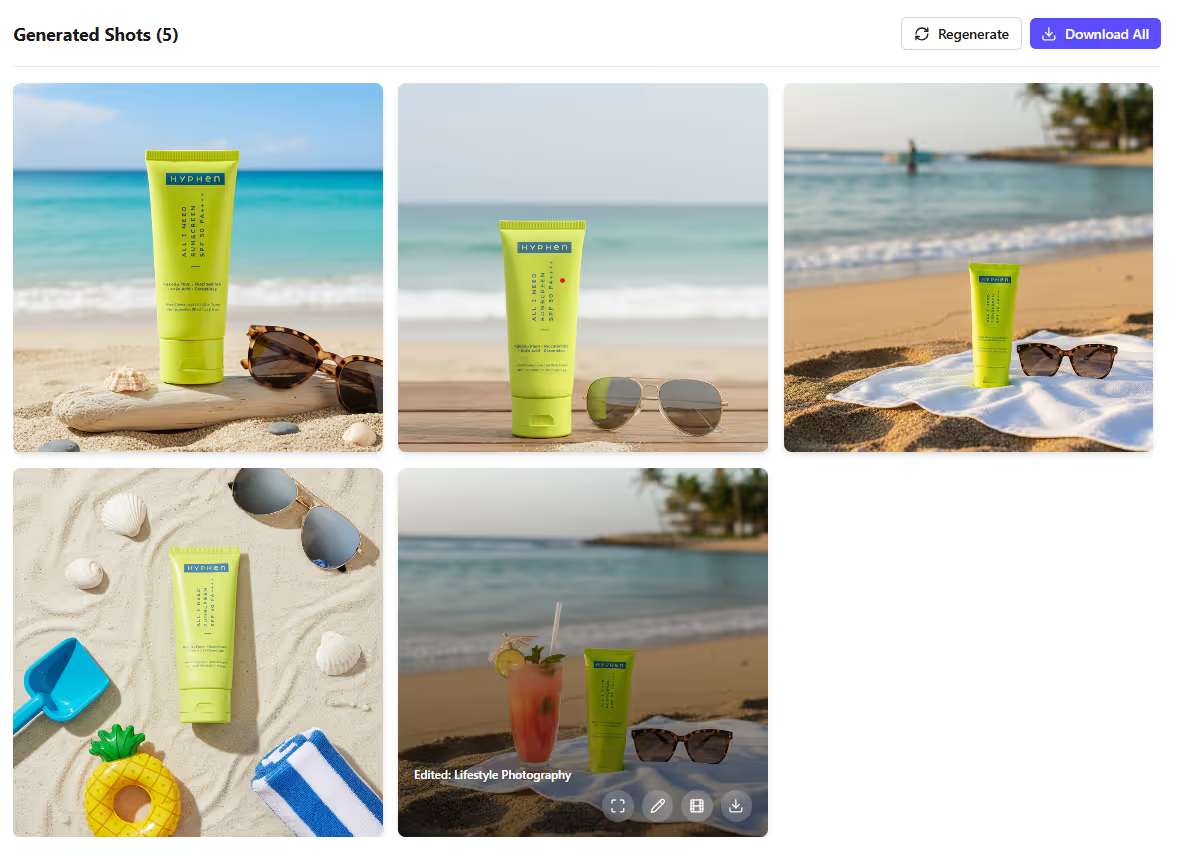
Yarnit’s AI product photography turns a single upload into a full campaign of high-converting lifestyle and studio images—ready to publish in minutes, not weeks.With one-click trend alignment and automatic optimization, your listings stay visually fresh, on-brand, and built to drive sales.
Scale Smarter with Yarnit’s AI-Powered Ecommerce Suite
For brands juggling thousands of SKUs across platforms, true scalability lives in the backend. That’s where Yarnit’s Retail Dashboard shines: a centralized command center that fuses AI-generated visuals with performance analytics. Track which beach-shot sunscreen or cozy-lifestyle hoodie drives the most clicks, auto-spin A/B variants to test in real time, and sync seamlessly with Shopify, WooCommerce, or Amazon. Spot a trending pastel palette on TikTok? One click refreshes your entire catalog, keeping listings fresh, on-brand, and conversion-optimized without manual chaos.
With Yarnit, you’re engineering desire, aligning every pixel with seasonal trends and buyer psychology. Sign up for Yarnit’s ecommerce suite today and generate your first AI-powered photoshoot. No studios. No delays. Just results.





.avif)




